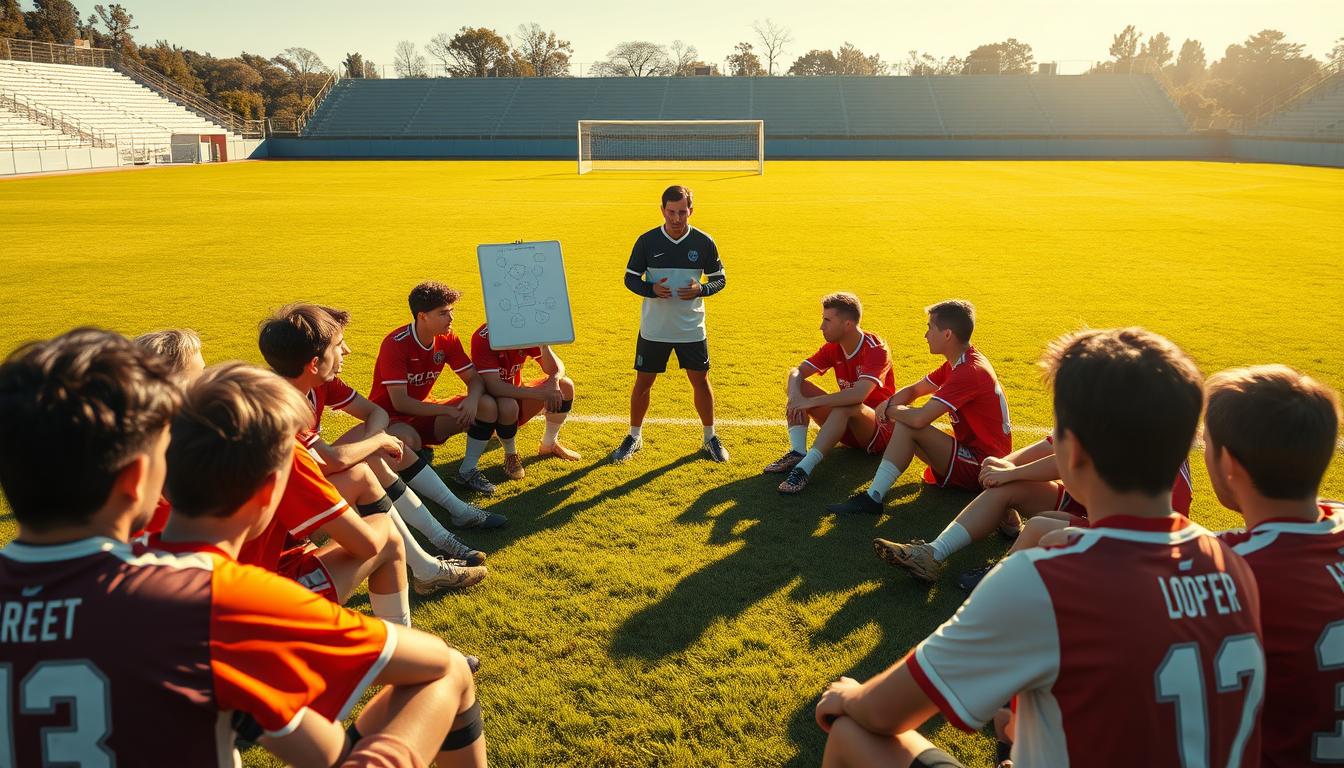Goal-Setting Activities for Soccer Teams

What separates championship contenders from squads that plateau? The answer lies in structured frameworks that turn raw effort into measurable progress. Whether you’re coaching beginners or refining elite players, intentional goal-setting bridges the gap between “good enough” and “exceptional.”
Vague aspirations like “play better” or “win more games” rarely drive improvement. Instead, proven systems break down ambitions into actionable steps everyone can follow. You’ll see how aligning individual growth with collective targets creates accountability and clarity—keys to unlocking your group’s full potential.
Key Takeaways
- Structured frameworks convert effort into measurable results
- Specific objectives outperform vague aspirations
- Accountability systems boost individual and group performance
- Goal alignment bridges skill gaps across experience levels
- Progressive milestones maintain motivation throughout seasons
Understanding the Basics of Goal Setting in Soccer
Effective progress starts with a roadmap everyone can follow. Without clear targets, effort gets scattered. Coaches who master foundational principles help players focus energy where it matters most.
Defining Clear Objectives
Great goals center on measurable actions, not hopes. Instead of “score more,” try “complete 85% of passes in the final third.” Performance-based targets let athletes control outcomes through skill development. Outcome goals like “win the league” often backfire—they depend on opponents and luck.
Benefits of SMART Goals
The SMART framework turns ideas into action. A youth player might aim to “improve weak-foot accuracy from 40% to 60% in eight weeks.” This plan is Specific (weak foot), Measurable (percentage increase), Achievable (20% growth), Relevant (position needs), and Time-bound (two months). Coaches using this method see faster skill growth at every level.
Clear objectives align expectations. When players understand exactly what to improve, practices become purposeful. You’ll create a culture where progress feels intentional, not accidental.
Soccer team goal-setting activities
Transform routine meetings into momentum-building sessions with interactive methods. Replace lecture-style talks with hands-on workshops where everyone contributes. Start by dividing your group into pairs to brainstorm specific targets for the next month. For example: “Complete 90% of short passes during drills” or “Make 5 recovery runs per half.”
Try vision boards during preseason camps. Give athletes magazines, markers, and poster boards to visualize objectives. One defender might paste images of clean sheets, while a striker adds goal celebration photos. Display these creations in locker rooms as daily reminders.
Use this template to balance collective and personal aims:
| Activity | Group Focus | Individual Target |
|---|---|---|
| Drill Sessions | 75% passing accuracy | 3 successful tackles/game |
| Fitness Tests | All members pass level 12 | Shave 2 seconds off sprint time |
| Match Prep | 20 crosses from wings | 4 key interceptions |
Rotate discussion leaders each week to engage quieter members. Try “silent brainstorming” where everyone writes ideas before sharing. For dominant personalities, assign them to summarize others’ suggestions rather than present their own.
Adjust difficulty levels based on age. Youth groups might track “assist streaks,” while veterans focus on tactical execution. Update targets every 4-6 weeks to maintain fresh challenges.
Implementing Strategies for Players and Coaches
Turning plans into results requires more than intention—it demands precise execution. Coaches need systems that translate ideas into daily actions, while players benefit from clear benchmarks to gauge growth. Let’s explore practical methods to bridge planning and progress.
Setting Performance-Oriented Goals
Start by defining specific targets players can control. For example: reduce goals conceded from 1.5 to 1 per match through focused defensive drills. Coaches might schedule weekly sessions improving backline positioning. These objectives create immediate action steps rather than vague hopes.
Measuring Progress with Specific Metrics
Track improvements using three methods:
- Statistics: Passing accuracy (85% target), tackles won
- Video analysis: Review decision-making in key moments
- Peer feedback: Teammates rate communication during matches
Create simple tracking sheets players update weekly. A midfielder might log successful through-balls, while goalkeepers record clean sheets. This builds accountability without overwhelming athletes. For youth soccer coaching strategies, focus on 1-2 metrics per player to maintain engagement.
Adjust goals every 6-8 weeks based on data trends. Celebrate hitting 70% of a target before pushing to 85%. This balance keeps motivation high while driving steady growth.
Overcoming Goal-Setting Obstacles
Even the best plans hit roadblocks. The key lies in spotting trouble early and adapting quickly. Let’s explore how to turn stumbling blocks into stepping stones.

Addressing Unrealistic Expectations
Social media highlights warp perceptions of success. Athletes might aim for pro-level skills before mastering basics. Help them reframe goals using current ability levels as starting points. Instead of “score like Messi,” try “land 3 accurate crosses per match.”
Break big dreams into weekly mini-goals. A player wanting to “improve dribbling” could focus on beating one defender in drills first. Celebrate hitting 70% of targets before raising the bar. This builds momentum while keeping challenges realistic.
Building Confidence Through Incremental Steps
Small wins create lasting motivation. Track progress with visible charts showing daily improvements. A defender afraid of failure might start by intercepting two passes per practice. Hitting this mark repeatedly builds belief in their skills.
Use setbacks as teaching moments. When someone misses a target, ask: “What worked?” and “What needs adjustment?” This shifts focus from failure to problem-solving. Pair struggling players with teammates who’ve overcome similar challenges.
Remember—growth isn’t linear. Adjust timelines if injuries or life events slow progress. Keep the atmosphere positive by highlighting effort over outcomes. You’ll help athletes achieve goals through consistent work, not luck.
Tools and Techniques to Monitor Progress
Tracking progress transforms good intentions into real results. Modern tools blend with traditional methods to show exactly how your group improves. Let’s explore systems that make growth visible and actionable.
Using Performance Trackers and Apps
Apps like Hudl and SoccerPulse simplify data collection. These platforms automatically log passes completed or sprints made during training. Players see real-time dashboards showing their weekly improvements—a powerful motivator.
For teams without tech budgets, try these low-cost options:
| Tool | Use Case | Frequency |
|---|---|---|
| Paper Journals | Tracking daily drills | Post-practice |
| Peer Reviews | Rating communication | Weekly |
| Fitness Charts | Recording sprint times | Biweekly |
Leveraging Video Analysis for Improvement
Record key moments from games to measure skill development. Compare a player’s first-touch control in August versus November clips. Focus on specific goals like maintaining proper body positioning during tackles.
Set up 10-minute video sessions twice monthly. Highlight three successes and one area to refine. Pair this with quick peer feedback rounds—teammates share tips using “start/stop/continue” frameworks.
Choose methods matching your resources. Youth groups might thrive with sticker charts celebrating small wins. Competitive squads could combine GPS trackers with biweekly progress reports. The right system keeps everyone engaged without draining coaches‘ time.
Integrating Goals into Training and Matches
Blend ambition with action by weaving objectives into every drill and match scenario. You’ll create habits that turn preseason targets into year-round results.
Practical Drills and Exercises
Transform standard exercises into goal-driven challenges. For passing accuracy, set up triangles where players must complete 10 consecutive one-touch passes before advancing. Track success rates weekly to show progress.
Try these approaches during practice:
| Drill | Focus Area | Success Metric |
|---|---|---|
| Wall Pass Relay | Ball control under pressure | 80% retention rate |
| Plyo Box Jumps | Leg strength development | +3″ vertical jump |
| 3v3 Zones | Defensive positioning | 30% fewer goals conceded |
Connect games to team goals through tactical tweaks. If improving wing play, require three crosses before taking shots during scrimmages. Review video clips post-match to highlight moments when players executed target behaviors.
For coaching staff: Start sessions with 5-minute goal reminders. “Today’s focus: 15+ interceptions during small-sided games.” End with player-led discussions about what worked. This keeps objectives at the forefront without feeling forced.
Final Reflections on Your Team’s Future
Michael Jordan’s Olympic gold medals and Lionel Messi’s record-breaking career didn’t happen by accident. Like these legends, your athletes’ journey begins with one clear goal—a North Star guiding every drill and decision.
Progress might zigzag. A player aiming for a college scholarship could face injuries or roster changes. But the process itself builds resilience that outlasts any single season. Those late-night practices and detailed tracking sheets? They’re teaching time management and grit applicable in classrooms and future careers.
When leadership shifts or results dip, your culture of accountability becomes the anchor. Keep celebrating small wins—a defender’s perfect tackle or a striker’s selfless pass. These moments reinforce that success isn’t just about trophies, but growth.
The real victory? Watching players apply goal-crushing strategies to life’s challenges. Maybe your midfielder uses target-setting tips to ace exams, or a keeper’s perseverance helps land their first job. That’s legacy-building work.
Every season offers new data to refine your approach. Stay curious, stay adaptable, and remember: today’s individual drills plant seeds for tomorrow’s leaders.
